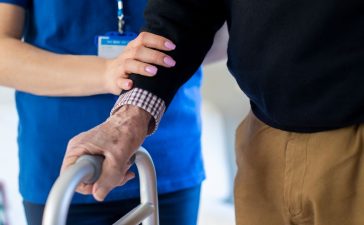Molly Meacher last week told the Commons health and social care committee inquiry into assisted dying about the decay, vomit and pain that often constitutes the daily existence of the terminally ill.
The Guardian’s social affairs correspondent called her submission “shocking”. If Lady Meacher’s description really made him or anyone else on the committee feel this way, I have one piece of advice: go and spend a day in an NHS hospice.
I’m in palliative care now for Huntington’s disease (HD). Like most people with this hereditary neurodegenerative disease, I started getting symptoms in my 40s. They are not pretty. As well as mood swings, forgetfulness and psychiatric problems, there are uncontrollable muscle spasms that affect my speech, movement and swallowing.
Although I can still live at home with a full-time carer (who has to feed me, dress me, pick me off the floor when I fall and stop me choking), I recently spent time in a palliative care hospice, while having a medication review.
It’s there that I experienced what I think of as my Huntington’s ground zero: time in a ward of dying people, literally screaming in pain. I made friends with the woman in the next bed, mainly because neither of us could speak – she is dying of a lung condition and I have the jerking, writhing muscle spasms typical of my condition, which render my speech close to incomprehensible – and we bonded as we tried to get someone to stop and listen to our vocalisations long enough to understand us.
Does that shock you? Well, that is what end of life looks like for me and will look like for many of you too. The staff did their best – I even met a nice padre who I convinced to read my book (I signed a copy for him) – but it is not the way I want to die. The palliative care system is underfunded and not fit for purpose with a one-size-fits-all, box-ticking approach to the end of life.

It’s shit enough dying furious and incapacitated and far too young, but it’s been made immeasurably worse by this system. I thought palliative care would give me more control over my final years – or at least some really, really good painkillers – but my experience has made me feel utterly helpless.
As part of a living will, I can tick boxes on medical forms requesting that I’m not treated for infections or that if I choke (the way many HD sufferers finally go), there’ll be no intervention. When you can actively sign up for these sorts of horrible, sudden deaths, it does feel perverse that you can’t tick a box asking for a simple end, one decided on by you, your family and your medics. I want self-determination between now and dying, and assisted dying is the only way left that I can achieve this. At this point of no return, it feels like the best solution.
I considered suicide when I was first diagnosed with HD back in 2006. In fact I was shocked when I started researching HD-related suicide that only one in four people with this illness tries to kill themselves. For a while, I was fascinated by death. I’d make trips to the Science Museum to admire Philip Nitschke’s “Deliverance” machine – a modified laptop that lets patients administer their own lethal dose. I devoured work by this Australian assisted death advocate. If it’s possible to have a wellbeing guru of death, then Nitschke is your man.
Back then, when I was asymptomatic, I only understood suicide as an intellectual proposition, and it felt like rhetoric. I didn’t want to die. I just wanted to avoid experiencing the catastrophic symptoms of HD. I also wasn’t ready to step away from the love, support and stimulation of my life, full as it was with family and work and friends. I thought that palliative care would see me through to the end, but I was wrong.
I understand now through the visceral experience of my illness that assisted death is not an easy option but a pragmatic solution to the physical and mental pain I am in. But, like so many deadlines before this, I’ve left it right until the last minute. I could not kill myself now as I can’t feed myself or fill a cup with water, let alone poison. But, as with my living will, British law presents me with a ridiculous conundrum. If I did try and kill myself and failed, I wouldn’t be prosecuted. But if my friends or doctors do the same job at my clear request, they would face prison.
I understand those arguing against assisted dying worry that vulnerable people might be coerced into suicide, especially the elderly. But I find it baffling that this is seen as valid opposition. Of course terrible things happen to innocent people, but when opinion polls show support for assisted dying, why would a hypothetical outcome take precedent over the reality of death?
Improving palliative care is the other alternative to assisted dying but, as someone waiting to see if I’m going to die in a fall or choke on some food, I don’t see what could be done to improve my situation.
Also, last year it was estimated that 100,000 people died without receiving any palliative care that could have made their demise a little bit less awful. Two-thirds of hospitals in England and Wales lack the necessary facilities for this intense level of care, while in 2019 the Royal College of Nursing noted that the number of NHS district nurses who could help with care at home had declined by 43% in the last 10 years. These are not figures that fill me with confidence.
End of life doesn’t need more of the same old, same old. It’s time we moved the story on. If you’re still not sure, do take up my original suggestion: spend a day in a hospice. Watch what dying is really like and then tell me that we terminally ill don’t deserve a new option.











